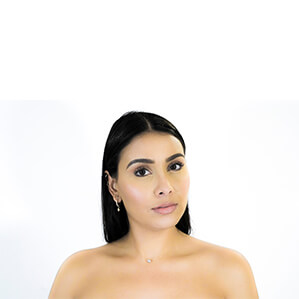 Matte skin is a term often used to define a certain category of complexion colors. The expression matte skin means that it looks naturally tanned. It is contrasted with pale skin that needs sun to have a darker appearance.
Matte skin is a term often used to define a certain category of complexion colors. The expression matte skin means that it looks naturally tanned. It is contrasted with pale skin that needs sun to have a darker appearance.
It is also common to evoke matte skin with black and mixed skin. Many common points exist between these multiple tones, which is why they are the subject of a global treatment.
However, it is important to know more precisely what it is when talking about matte skin to allow the women and men concerned to identify their complexion. In'Oya defines its characteristics and the interest of knowing its specificities to take care of your matte skin on a daily basis.
THE DIFFERENT SHADES OF MATTE SKIN
From light skin to black skin, there are many shades. Maghreb skin is easily associated with matte skin. More generally, the so-called Mediterranean skins are also related to this term. But sometimes, it's not as easy to navigate among the many appellations.
Dermatologist Thomas Fitzpatrick's phototype categorization technically classified the different skin types. Its goal was to allow everyone to effectively protect their skin from the effects of the sun. Each phototype is determined according to tone, UV resistance, hair and eye color. Our solar diagnosis is based on this tool.
Matte skin corresponds to phototype 4, while very matte skin is relative to phototype 5. The following elements are associated with phototypes 4 and 5 : brown or chestnut hair, without freckle. The skin is very tolerant to the sun, it tans easily, with little risk of burns (occasional to rare). The eyes are, usually, brown or black.
The descriptions are very similar, even similar on some points. A complementary scale includes ethnicity : African, Asian, East Indian, Hispanic, Maghreb, Middle Eastern and Native American. But this differentiation is complex, because it is sometimes based on several generations. In addition, today, with the growing diversity, this element is not necessarily characteristic. In all cases, the needs are almost identical.
The color of matte skin is determined based on the amount of two types of melanin. The mixture of certain proportions of phaeomelanins (red melanins) and eumelanins (black melanins) is at the origin of this natural tanned appearance. Logically, the proportion of black melanin is higher than for fair-skinned individuals. On the other hand, it is less important than for those with very dark skin.
Finally, it is common to see confusions about the meaning of the term "matte" with that of a skin whose surface is "mattified". Indeed, in this case, it is an epidermis without excess sebum, not shiny. Nothing to do, therefore, with skin color!
MATTE SKIN & BLACK SKIN: A COMMON FIGHT AGAINST PIGMENT SPOTS
In dermocosmetics, it is common to talk about black and matte skin at the same time. These two categories of skin are both concerned by the problem of pigment spots. But people with matte skin do not always make the connection with the specificities of black skin.
Whatever their origins - Maghreb, Mediterranean, etc. - they are more traditionally moving towards products for Caucasian skin. They sometimes have such a light complexion that they do not necessarily think about looking for a anti-stain cosmetic product designed for matte skin.
Yet for all matte skin, the appearance of brown spots can unfortunately occur in multiple situations:
- Sun exposure
- Scar
- Acne pimples
- Hormonal imbalance (pregnancy, menopause, etc.)
Their shape, size, color varies according to each individual, but in any case, it is not inevitable. Two axes are to be considered : prevention and treatment.
Regarding prevention, it is especially recommended to bring protection against UV rays. As with people with black skin, the most common mistake made by those with matte skin is to judge sunscreen superfluous. They are not very prone to sunburn. Therefore, it is only with the appearance of darker marks on the face or body that they really learn about the dangers of UV rays.
Taking into consideration the peculiarities of matte skin is of great importance in curative treatment. To reduce or eliminate hyperpigmentation spots, it is recommended to apply anti-stain products designed for matte to dark skin. Adapted to their characteristics, this appropriate care is very effective. They act in a targeted way, regardless of the origin of the pigment marks (inflammatory, solar or hormonal).
DULL COMPLEXION: THE OTHER PROBLEM OF MATTE SKIN
The main advantage of matte skin is, by definition, a pretty tanned color. However, in some cases, matte skin tends to gray out. It is even said that matte skin has an olive complexion. Its ability to reflect light is less important than other tones. Before trying to brighten your complexion with makeup, remember to act directly on the causes. A dull complexion can be due to multiple factors :
- Lack of sun
- Stress
- Pollution
- Dehydration
- Lack of essential nutrients, etc.
In reality, it is not always easy to understand where this grayish mine comes from. A change of season? A new rhythm of life? Overwork? Take the time to review what may have played on the tired appearance of your skin. In any case, you can, without risk, return to the basics to find a luminous complexion:
- Review your diet to make it richer in vitamins and minerals
- Incorporate healthy drinks throughout the day to hydrate well
- Walk at least 30 minutes each day to oxygenate your body
- Insert each week 2 to 3 sessions of a sport that you like
- Get enough sleep at your own pace (the ideal number of hours depends on each individual)
To restore radiance to the matte complexion, we recommend that you opt for an In & Out routine. In'Oya's research team has developed a program to illuminate it as early as 28 days. Concretely, the synergy of food compliments associated with cosmetics offers an integral care to unify and sublimate the complexion. This combination therefore targets the two common problems of matte skin: pigment spots and dull complexion.
At the same time, we recommend that you check if you know your skin type well: normal, dry, sensitive, or mixed, or even oily. Sometimes people with matte skin think that their epidermis is rather dry, because they confuse matte and mattified. They therefore use products that are not in line with their particular needs.
To know your skin type accurately, take our free online test to determine it in a matter of moments. You will then be able to benefit from a routine appropriate to your problems, with confidence.
The expression "matte skin" is also widely used in make-up. It allows you to locate yourself to find the complexion products, powders or blushes adapted to your complexion. To go further, find our tips to know the colors that enhance your matte skin.







